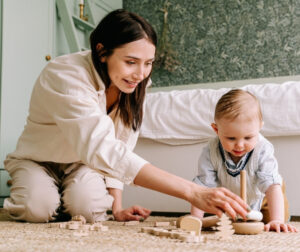Activities for Better Naps and Milestone Development
By Katie Briggs, MSPT, CIMT2, CPMT
Owner and Infant Development Coach, Supported Start Infant Development
Timing is everything
We’ve all been there. You want to provide your baby with activities to help with their development, but between naps, feedings, chores, and diaper changes (let alone work if you’re getting that in too!) the day has gone by and you’re just happy to have survived it. I’m here to congratulate you on getting through the day – no small feat – and let you know that with a little bit of timing and awareness, there are simple things you can do to encourage those developmental milestones… while helping with your little one’s sleep as well!
Timing your baby’s activities can be tricky. One way to have better luck fitting in developmental activities is by knowing approximately how long you might have between naps. Wake windows gradually get longer as your baby gets older. A newborn, for example, might only be awake for 30 to 90 minutes at a time, a six-month-old typically stays awake for 2-3 hours, and a 12-month-old might be up for 3-4 hours between naps. If you note what time your baby woke up, and you know about how long their wake windows tend to be, you can be a little more intentional with getting some activity time in.
For a baby’s first few months, timing activity within a wake window can also make a difference. Babies are most receptive to activities during the quiet alert state. This state is characterized by baby’s eyes being wide open (a look like they’re “taking it all in”), limited and relatively soft vocalization (if any), and their body remaining calm. The quiet alert state happens between the drowsy state (when they’re coming out of sleep) and the active alert state (when they start to get fussy and their body is moving a lot more).

Floor time and purposeful play
Now you know how to best time your baby’s play activities, what activities are best?
My number one recommendation is to make sure your baby is getting floor time. By this, I mean you place them on the floor and let them move in whatever way their body is capable. For a tiny baby, this might be under a play gym arch, looking at toys hanging above them and to the sides. For a roller/pre-crawler, this might mean putting some toys around them in a circle, encouraging them to roll towards them or pivot on their belly. For a baby who’s crawling, you might place toys in different spots and at different heights around the room, encouraging them to experiment with how to get to them and explore the environment that is now within reach.
Purposeful play is another key component to encouraging infant development. This is when you play with your baby in ways that intentionally target a specific developmental milestone that your baby is working on. Below is a list of ways to do this, based on your baby’s approximate age:
- 0-3 months: Tummy time, including propped up on a parent’s chest or nursing pillow. Back play, including visually tracking objects and assisted hands to midline. Supported side-lying play. Facilitated reaching practice.
- 4-6 months: Targeted reaching practice. Rolling practice. Supported sitting practice.
- 6-9 months: Seated play, including reaching in sitting. Assisted hands-and-knees. Assisted kneeling play.
- 9-12 months: Encouraging crawling. Kneeling play. Practicing pull-to-stand. Supported standing play at a surface. Encouraging cruising at a surface.
What to expect
Like older children and adults, babies burn energy when they’re active. Adding a little well-timed floor time and purposeful play to your baby’s wake windows will promote better sleep.
In addition, working on activities specific to where your baby is developmentally will help them reach their motor milestones (rolling, sitting, crawling, walking, and everything in between), which, in turn, facilitates cognitive and language development. I’m not exaggerating when I say that a little bit of simple purposeful play really makes an impact!

When to seek help
If working on the above seems overwhelming and/or you’d like more specific purposeful play activities for your baby’s age and stage, shoot me a message and we can chat. If you suspect your baby is falling behind in their motor skills, listen to that parent-gut and talk to your pediatrician. A physical therapy evaluation might be appropriate.
Better naps and milestone progress
Hopefully the above is a good addition to your arsenal of tools to assist with your baby’s sleep! And of course, the physical therapist and developmental coach in me is also rooting for your little one’s progress with their milestones.
Congrats on getting through these tricky days, parents! You’re doing great.
Disclaimer: The information provided here is for educational purposes only and does not substitute for professional medical advice.
